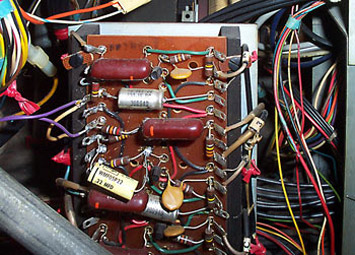X 66
North Suburban HAMMOND ORGAN Service

Figure 18. Console Preamplifier Board.
This next picture shows the console preamplifier. The signals from three of the four audio channels in the console (drawbars A, drawbars B, and tab voices) come in on the right side of this unit and get amplified before finally appearing on the specified terminals of the output sockets in the console connector assembly where the cables for the speaker cabinets get attached. The X66 speaker system has 5 audio channels, the fifth one being a derived bass channel. The tab voice signals which include the bass pedal tones go through a crossover network in the speaker cabinet, and the low frequencies are then amplified separately and sent to a 15" woofer in a bass reflex enclosure.The reverb unit signal goes through a separate reverb preamp before appearing at the output sockets.
In deriving the bass this way, the Hammond system is actually using the preferred approach. In many audio systems, there's a single power amplifier and then there is a cross-over network right before the speakers that separates the bass from the treble. But the better way to accomplish this is to do the separation of bass and treble BEFORE the power amplifier, and then provide independent power amplifiers for bass, and treble and mid-range tones. Both power amplifiers can then be designed specifically for their intended frequency ranges and speakers. Unlike traditional Hammond organs and also the Wulitzer 4600 series instruments which are single audio channel instruments, the X66 as designed provides its audio output as a 5 channel signal, one of the reasons for the superior tonal effects of this instrument.
We should note, however, that in many Hammond tone cabinets, the bass and treble and in some cases the reverb signal are sent to separate power amplifier channels and speakers. The traditional Hammond console outputs are mono; being simple single-channel outputs. There is technically a stereo effect in the literal definition of that word in those speaker cabinets where bass and treble tones are separated and amplified independently, and a true stereo results if the reverb signal is independently amplified and goes to speakers which specifically handle the reverb signal only. The console outputs however are mono, whereas in the X66, there are four independent audio channels leaving the console which are tibia A and B, tab or "bright" voices, and also the reverb signal. If the vibrato and the celeste effects are "off" on the X66, then technically, the A and B channels carry the identical signal, so in that respect they are not a true stereo. But when the vibrato is on, then because of the "two phase" vibrato and celeste effects, a true stereo results. Also, if any type of Hammond is fitted with a Leslie speaker, then an almost infinitely complex stereo will result. An article on Leslie speakers is planned for this series very soon. That article is now complete. You can find it here: Leslie Speakers. I will continue with the rest of the X66 as time permits. Meanwhile, this will at least get you started in understanding Hammond's most versatile and interesting instrument.
Previous Page Page 14. Next page